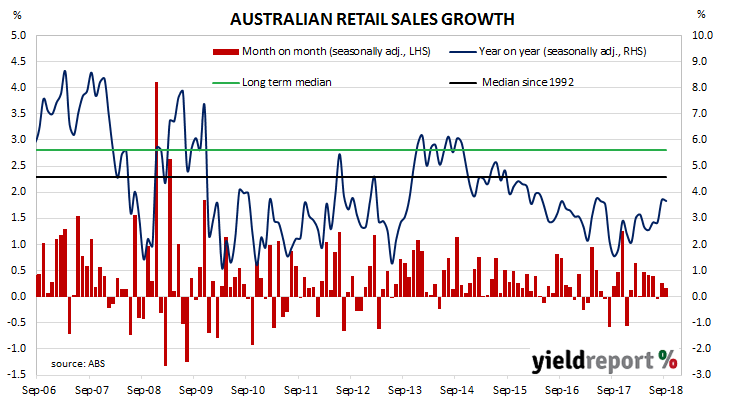Retail sales figures have been lacklustre for the past couple of years despite a declining savings rate. Economists have explained the low growth rate as a result of record household debt and a low rate of income growth. There are also the effects of price deflation on sales figures which, unlike many other economic reports, are not adjusted for inflation. However, 2018 sales figures to date have generally exceeded market expectations while being vastly higher than the same period in 2017, even though the latest figures do not . Having said that, the latest figures do not fit in with this theme.
According to the latest ABS figures, total retail sales increased by 0.2% over the month on a seasonally-adjusted basis, under the 0.3% increase expected and a drop from August’s revised figure of +0.3%. However, on an annual basis, retail sales increased by 3.7%, the same as August’s revised figure.
ANZ senior economist Cherelle Murphy said, “Retail volume growth was disappointing in the September quarter, and the solid June quarter was revised down a little. A pronounced sawtooth pattern in quarterly sales has been evident for some time.”
 Local bond yields finished the day higher despite lower yields in US markets. The yield on 3-year ACGBs added 4bps to 2.12% while the 10-year and 20-year ACGBs each gained 5bps to 2.71% and 3.05% respectively. The Aussie dollar finished the day session fairly flat at 72.10 US cents while prices of cash futures contracts moved to imply a slightly higher chance of a rate rise in any particular month in the second half of 2019 and early 2020.
Local bond yields finished the day higher despite lower yields in US markets. The yield on 3-year ACGBs added 4bps to 2.12% while the 10-year and 20-year ACGBs each gained 5bps to 2.71% and 3.05% respectively. The Aussie dollar finished the day session fairly flat at 72.10 US cents while prices of cash futures contracts moved to imply a slightly higher chance of a rate rise in any particular month in the second half of 2019 and early 2020.

